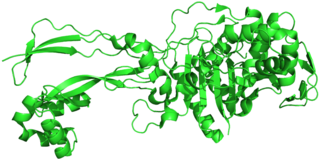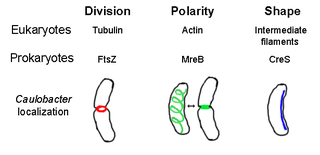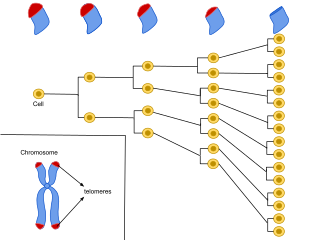Related Research Articles
Cell biology is a branch of biology that studies the structure, function, and behavior of cells. All living organisms are made of cells. A cell is the basic unit of life that is responsible for the living and functioning of organisms. Cell biology is the study of the structural and functional units of cells. Cell biology encompasses both prokaryotic and eukaryotic cells and has many subtopics which may include the study of cell metabolism, cell communication, cell cycle, biochemistry, and cell composition. The study of cells is performed using several microscopy techniques, cell culture, and cell fractionation. These have allowed for and are currently being used for discoveries and research pertaining to how cells function, ultimately giving insight into understanding larger organisms. Knowing the components of cells and how cells work is fundamental to all biological sciences while also being essential for research in biomedical fields such as cancer, and other diseases. Research in cell biology is interconnected to other fields such as genetics, molecular genetics, molecular biology, medical microbiology, immunology, and cytochemistry.

Chemotaxis is the movement of an organism or entity in response to a chemical stimulus. Somatic cells, bacteria, and other single-cell or multicellular organisms direct their movements according to certain chemicals in their environment. This is important for bacteria to find food by swimming toward the highest concentration of food molecules, or to flee from poisons. In multicellular organisms, chemotaxis is critical to early development and development as well as in normal function and health. In addition, it has been recognized that mechanisms that allow chemotaxis in animals can be subverted during cancer metastasis. The aberrant chemotaxis of leukocytes and lymphocytes also contribute to inflammatory diseases such as atherosclerosis, asthma, and arthritis. Sub-cellular components, such as the polarity patch generated by mating yeast, may also display chemotactic behavior.

Cell division is the process by which a parent cell divides into two daughter cells. Cell division usually occurs as part of a larger cell cycle in which the cell grows and replicates its chromosome(s) before dividing. In eukaryotes, there are two distinct types of cell division: a vegetative division (mitosis), producing daughter cells genetically identical to the parent cell, and a cell division that produces haploid gametes for sexual reproduction (meiosis), reducing the number of chromosomes from two of each type in the diploid parent cell to one of each type in the daughter cells. Mitosis is a part of the cell cycle, in which, replicated chromosomes are separated into two new nuclei. Cell division gives rise to genetically identical cells in which the total number of chromosomes is maintained. In general, mitosis is preceded by the S stage of interphase and is followed by telophase and cytokinesis; which divides the cytoplasm, organelles, and cell membrane of one cell into two new cells containing roughly equal shares of these cellular components. The different stages of mitosis all together define the M phase of an animal cell cycle—the division of the mother cell into two genetically identical daughter cells. To ensure proper progression through the cell cycle, DNA damage is detected and repaired at various checkpoints throughout the cycle. These checkpoints can halt progression through the cell cycle by inhibiting certain cyclin-CDK complexes. Meiosis undergoes two divisions resulting in four haploid daughter cells. Homologous chromosomes are separated in the first division of meiosis, such that each daughter cell has one copy of each chromosome. These chromosomes have already been replicated and have two sister chromatids which are then separated during the second division of meiosis. Both of these cell division cycles are used in the process of sexual reproduction at some point in their life cycle. Both are believed to be present in the last eukaryotic common ancestor.

Escherichia coli ( ESH-ə-RIK-ee-ə KOH-ly) is a gram-negative, facultative anaerobic, rod-shaped, coliform bacterium of the genus Escherichia that is commonly found in the lower intestine of warm-blooded organisms. Most E. coli strains are harmless, but some serotypes such as EPEC, and ETEC are pathogenic and can cause serious food poisoning in their hosts, and are occasionally responsible for food contamination incidents that prompt product recalls. Most strains are part of the normal microbiota of the gut and are harmless or even beneficial to humans (although these strains tend to be less studied than the pathogenic ones). For example, some strains of E. coli benefit their hosts by producing vitamin K2 or by preventing the colonization of the intestine by pathogenic bacteria. These mutually beneficial relationships between E. coli and humans are a type of mutualistic biological relationship — where both the humans and the E. coli are benefitting each other. E. coli is expelled into the environment within fecal matter. The bacterium grows massively in fresh fecal matter under aerobic conditions for three days, but its numbers decline slowly afterwards.

β-Galactosidase is a glycoside hydrolase enzyme that catalyzes hydrolysis of terminal non-reducing β-D-galactose residues in β-D-galactosides.

FtsZ is a protein encoded by the ftsZ gene that assembles into a ring at the future site of bacterial cell division. FtsZ is a prokaryotic homologue of the eukaryotic protein tubulin. The initials FtsZ mean "Filamenting temperature-sensitive mutant Z." The hypothesis was that cell division mutants of E. coli would grow as filaments due to the inability of the daughter cells to separate from one another. FtsZ is found in almost all bacteria, many archaea, all chloroplasts and some mitochondria, where it is essential for cell division. FtsZ assembles the cytoskeletal scaffold of the Z ring that, along with additional proteins, constricts to divide the cell in two.

Caulobacter crescentus is a Gram-negative, oligotrophic bacterium widely distributed in fresh water lakes and streams. The taxon is more properly known as Caulobacter vibrioides.
Biological immortality is a state in which the rate of mortality from senescence is stable or decreasing, thus decoupling it from chronological age. Various unicellular and multicellular species, including some vertebrates, achieve this state either throughout their existence or after living long enough. A biologically immortal living being can still die from means other than senescence, such as through injury, poison, disease, predation, lack of available resources, or changes to environment.

Filamentation is the anomalous growth of certain bacteria, such as Escherichia coli, in which cells continue to elongate but do not divide. The cells that result from elongation without division have multiple chromosomal copies.

Penicillin-binding proteins (PBPs) are a group of proteins that are characterized by their affinity for and binding of penicillin. They are a normal constituent of many bacteria; the name just reflects the way by which the protein was discovered. All β-lactam antibiotics bind to PBPs, which are essential for bacterial cell wall synthesis. PBPs are members of a subgroup of enzymes called transpeptidases. Specifically, PBPs are DD-transpeptidases.
Virulence factors are cellular structures, molecules and regulatory systems that enable microbial pathogens to achieve the following:
Microbial genetics is a subject area within microbiology and genetic engineering. Microbial genetics studies microorganisms for different purposes. The microorganisms that are observed are bacteria, and archaea. Some fungi and protozoa are also subjects used to study in this field. The studies of microorganisms involve studies of genotype and expression system. Genotypes are the inherited compositions of an organism. Genetic Engineering is a field of work and study within microbial genetics. The usage of recombinant DNA technology is a process of this work. The process involves creating recombinant DNA molecules through manipulating a DNA sequence. That DNA created is then in contact with a host organism. Cloning is also an example of genetic engineering.

Bacteria are ubiquitous, mostly free-living organisms often consisting of one biological cell. They constitute a large domain of prokaryotic microorganisms. Typically a few micrometres in length, bacteria were among the first life forms to appear on Earth, and are present in most of its habitats. Bacteria inhabit soil, water, acidic hot springs, radioactive waste, and the deep biosphere of Earth's crust. Bacteria play a vital role in many stages of the nutrient cycle by recycling nutrients and the fixation of nitrogen from the atmosphere. The nutrient cycle includes the decomposition of dead bodies; bacteria are responsible for the putrefaction stage in this process. In the biological communities surrounding hydrothermal vents and cold seeps, extremophile bacteria provide the nutrients needed to sustain life by converting dissolved compounds, such as hydrogen sulphide and methane, to energy. Bacteria also live in mutualistic, commensal and parasitic relationships with plants and animals. Most bacteria have not been characterised and there are many species that cannot be grown in the laboratory. The study of bacteria is known as bacteriology, a branch of microbiology.

The prokaryotic cytoskeleton is the collective name for all structural filaments in prokaryotes. It was once thought that prokaryotic cells did not possess cytoskeletons, but advances in visualization technology and structure determination led to the discovery of filaments in these cells in the early 1990s. Not only have analogues for all major cytoskeletal proteins in eukaryotes been found in prokaryotes, cytoskeletal proteins with no known eukaryotic homologues have also been discovered. Cytoskeletal elements play essential roles in cell division, protection, shape determination, and polarity determination in various prokaryotes.

Cellular senescence is a phenomenon characterized by the cessation of cell division. In their experiments during the early 1960s, Leonard Hayflick and Paul Moorhead found that normal human fetal fibroblasts in culture reach a maximum of approximately 50 cell population doublings before becoming senescent. This process is known as "replicative senescence", or the Hayflick limit. Hayflick's discovery of mortal cells paved the path for the discovery and understanding of cellular aging molecular pathways. Cellular senescence can be initiated by a wide variety of stress inducing factors. These stress factors include both environmental and internal damaging events, abnormal cellular growth, oxidative stress, autophagy factors, among many other things.

Bacterial motility is the ability of bacteria to move independently using metabolic energy. Most motility mechanisms that evolved among bacteria also evolved in parallel among the archaea. Most rod-shaped bacteria can move using their own power, which allows colonization of new environments and discovery of new resources for survival. Bacterial movement depends not only on the characteristics of the medium, but also on the use of different appendages to propel. Swarming and swimming movements are both powered by rotating flagella. Whereas swarming is a multicellular 2D movement over a surface and requires the presence of surfactants, swimming is movement of individual cells in liquid environments.
Fission, in biology, is the division of a single entity into two or more parts and the regeneration of those parts to separate entities resembling the original. The object experiencing fission is usually a cell, but the term may also refer to how organisms, bodies, populations, or species split into discrete parts. The fission may be binary fission, in which a single organism produces two parts, or multiple fission, in which a single entity produces multiple parts.
Bacterial morphological plasticity refers to changes in the shape and size that bacterial cells undergo when they encounter stressful environments. Although bacteria have evolved complex molecular strategies to maintain their shape, many are able to alter their shape as a survival strategy in response to protist predators, antibiotics, the immune response, and other threats.

The universal stress protein (USP) domain is a superfamily of conserved genes which can be found in bacteria, archaea, fungi, protozoa and plants. Proteins containing the domain are induced by many environmental stressors such as nutrient starvation, drought, extreme temperatures, high salinity, and the presence of uncouplers, antibiotics and metals.

The divisome is a protein complex in bacteria that is responsible for cell division, constriction of inner and outer membranes during division, and peptidoglycan (PG) synthesis at the division site. The divisome is a membrane protein complex with proteins on both sides of the cytoplasmic membrane. In gram-negative cells it is located in the inner membrane. The divisome is nearly ubiquitous in bacteria although its composition may vary between species.
References
- ↑ Nyström, Thomas (2003-03-25). "Conditional senescence in bacteria: death of the immortals: Bacterial senescence". Molecular Microbiology. 48 (1): 17–23. doi: 10.1046/j.1365-2958.2003.03385.x . PMID 12657042. S2CID 35548948.
- 1 2 Ackermann, M.; Stearns, S. C.; Jenal, U. (2003). "Senescence in a bacterium with asymmetric division". Science. 300 (5627): 1920. doi:10.1126/science.1083532. PMID 12817142. S2CID 34770745.
- 1 2 Stewart, E. J.; Madden, R.; Paul, G.; Taddei, F. (2005). "Aging and Death in an Organism That Reproduces by Morphologically Symmetric Division". PLOS Biology. 3 (2): e45. doi: 10.1371/journal.pbio.0030045 . PMC 546039 . PMID 15685293.
- 1 2 Lindner, A. B.; Madden, R.; Demarez, A.; Stewart, E. J.; Taddei, F. (2008). "Asymmetric segregation of protein aggregates is associated with cellular aging and rejuvenation". Proceedings of the National Academy of Sciences of the United States of America. 105 (8): 3076–3081. Bibcode:2008PNAS..105.3076L. doi: 10.1073/pnas.0708931105 . PMC 2268587 . PMID 18287048.
- 1 2 Wang, Ping; Lydia Robert; James Pelletier; Wei Lien Dang; Francois Taddei; Andrew Wright; Suckjoon Jun (2010). "Robust Growth of E. coli". Current Biology. 20 (12): 1099–103. doi:10.1016/j.cub.2010.04.045. PMC 2902570 . PMID 20537537.
- ↑ Watve, Milind; Parab, S.; Jogdand, P.; Keni, S. (October 2006). "Aging may be a conditional strategic choice and not an inevitable outcome for bacteria". Proceedings of the National Academy of Sciences of the United States of America. 103 (40): 14831–5. Bibcode:2006PNAS..10314831W. doi: 10.1073/pnas.0606499103 . PMC 1595437 . PMID 17001004.
- ↑ Kirkwood, T. B. L. (1981). Repair and its evolution: survival versus reproduction. Physiological Ecology ; an Evolutionary Approach to Resource Use.
- ↑ Aguilaniu, H.; Gustafsson, L.; Rigoulet, M.; Nystroem, T. (2003). "Asymmetric inheritance of oxidatively damaged proteins during cytokinesis". Science. 299 (5613): 1751–1753. Bibcode:2003Sci...299.1751A. doi: 10.1126/science.1080418 . PMID 12610228. S2CID 21337636.
- ↑ Kohn, Michael H.; Murphy, William J.; Ostrander, Elaine A.; Wayne, Robert K. (2006-11-01). "Genomics and conservation genetics". Trends in Ecology & Evolution. 21 (11): 629–637. doi:10.1016/j.tree.2006.08.001. ISSN 0169-5347. PMID 16908089.
- ↑ Nystroem, T (2007). "A bacterial kind of aging". PLOS Genetics. 3 (12): 2355–2357. doi: 10.1371/journal.pgen.0030224 . PMC 2134940 . PMID 18085827.
- ↑ Steiner, Ulrich Karl (2021). "Senescence in Bacteria and Its Underlying Mechanisms". Frontiers in Cell and Developmental Biology. 9: 668915. doi: 10.3389/fcell.2021.668915 . ISSN 2296-634X. PMC 8249858 . PMID 34222238.
- ↑ Way, J. C. (February 1996). "The mechanism of bacterial asymmetric cell division". BioEssays: News and Reviews in Molecular, Cellular and Developmental Biology. 18 (2): 99–101. doi:10.1002/bies.950180205. ISSN 0265-9247. PMID 8851042.
- ↑ Moseley, J. B. (2013). "Cellular Aging: Symmetry Evades Senescence". Current Biology. 23 (19): R871–R873. doi:10.1016/j.cub.2013.08.013. PMC 4276399 . PMID 24112980.
- ↑ Coquel, A.-S.; Jacob, J.-P.; Primet, M.; Demarez, A.; Dimiccoli, M.; Julou, T.; et al. (2013). "Localization of Protein Aggregation in Escherichia coli Is Governed by Diffusion and Nucleoid Macromolecular Crowding Effect". PLOS Computational Biology. 9 (4): 4. arXiv: 1303.1904 . Bibcode:2013PLSCB...9E3038C. doi: 10.1371/journal.pcbi.1003038 . PMC 3636022 . PMID 23633942.
- ↑ Coelho, M.; Dereli, A.; Haese, A.; Kühn, S.; Malinovska, L. (2013). "Fission yeast does not age under favorable conditions, but does so after stress". Current Biology. 23 (19): 1844–52. doi:10.1016/j.cub.2013.07.084. PMC 4620659 . PMID 24035542.
- ↑ Robert, Lydia; Ollion, Jean; Robert, Jerome; Song, Xiaohu; Matic, Ivan; Elez, Marina (2018-03-16). "Mutation dynamics and fitness effects followed in single cells". Science. 359 (6381): 1283–1286. doi: 10.1126/science.aan0797 . ISSN 0036-8075. PMID 29590079. S2CID 4548806.
- ↑ Proenca, Audrey Menegaz; Rang, Camilla Ulla; Qiu, Andrew; Shi, Chao; Chao, Lin (2019-05-23). "Cell aging preserves cellular immortality in the presence of lethal levels of damage". PLOS Biology. 17 (5): e3000266. doi: 10.1371/journal.pbio.3000266 . ISSN 1545-7885. PMC 6532838 . PMID 31120870.